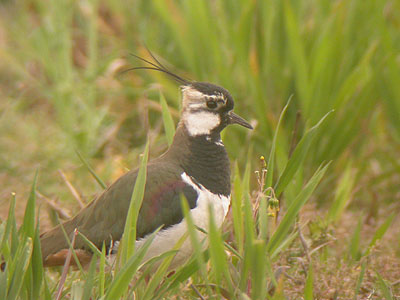

| Eakring Birds |
| Breeding bird survey 1998 |
| The 1998
breeding survey showed that the region held a total of 63
breeding species. The majority of these are found in
sufficient numbers, so as not to give any cause for
concern at the present time. However, there are some species which can be regarded as in danger of being lost as breeding species and these are discussed below. Of course there are some primary factors governing these threats to certain species. Habitat loss due to current farming practises, the use of pesticides and species that are on a downward trend nationally due to subtle climatic changes. Traditional farmland species continue to be under the largest threat today and this was found during the survey, though it must be stressed that not all of the area's threatened species are due to current farming methods. Goldcrest and Coal Tit have a low breeding populations due to restrictions in habitat. In the case of the Lesser Whitethroat (another scarce breeder) there remains enough available habitat and reasons for it's scarcity remain at the present time a mystery. Both Lapwing and Grey Partridge occur in low numbers. The most obvious factors are the over-use of pesticides/herbicides and the ploughing up of meadowland (Now found in such short supply within the region, that several species are on the verge of being lost here as a result) |
||
| ..... | ||
 |
The 1998 breeding survey
showed that the region held a total of 63 breeding
species. The majority of these are found in sufficient
numbers, so as not to give any cause for concern at the
present time. However, there are some species which can
be regarded as in danger of being lost as breeding
species and these are discussed below. Of course there are some primary factors governing these threats to certain species. Habitat loss due to current farming practises, the use of pesticides and species that are on a downward trend nationally due to subtle climatic changes. Traditional farmland species continue to be under the largest threat today and this was found during the survey, though it must be stressed that not all of the area's threatened species are due to current farming methods. Goldcrest and Coal Tit have a low breeding populations due to restrictions in habitat. In the case of the Lesser Whitethroat (another scarce breeder) there remains enough available habitat and reasons for it's scarcity remain at the present time a mystery. Both Lapwing and Grey Partridge occur in low numbers. |
|
| ..... | ||
The most obvious factors are the over-use of pesticides/herbicides and the ploughing up of meadowland (Now found in such short supply within the region, that several species are on the verge of being lost here as a result) Two other species, once common and so typical of the county's farmland are the Turtle Dove and Tree Sparrow. Now totalling only seven pairs between them, both face an uphill struggle to survive during the coming years. Notorious hole nesters, the Tree Sparrow's decline cannot be due to the lack of suitable nesting sites alone. It seems that the use of pesticidal sprays are the primary cause for their decline here. Turtle Doves face not only the lack of suitable habitat here, with many of the old hedges now gone, but also the hunter's gun on Continental Europe. Several species with small breeding populations held large territories. Whether this was in fact due to restricted habitat is unlikely in the case of this first group (Great Spotted Woodpecker, Sparrowhawk, Kestrel, Little Owl and Carrion Crow) With the exception of the Great Spotted Woodpecker, all four other species were highly aggressive towards intruders, either akin or otherwise and generally had nesting sites several kilometres apart. The Carrion Crow's nest site distribution over the area, proved relatively even and widespread, giving a total of six occupied territories. The three Little Owl nests were just under 2km apart and birds hunted within several hundred metres of their own nest site. No evidence of nomadic tendencies were found and in all three cases, there was no vacation of the nesting site during the Winter months. Possibly this was due to the almost constant threat of eviction by Jackdaws. Kestrel territories proved to be very similar to those of the Little Owl. Evenly spread across the area, although hunting ranges were considerably larger. Both the Sparrowhawk and Great Spotted Woodpecker's restriction seems due to the lack of woodland within the region. This obviously has an effect on the breeding population of both species and so the current total is unlikely to expand over the years. As such, both species can afford to have a large territory in which to hunt. The area also holds certain species which seem inclined to breed in very loose colonies. The two most notable species for this were the Skylark and Lapwing. Three main areas held such nesting colonies in the case of the Skylark, Red Hill, Church Hill and an area north of Eakring Field Farm. Interestingly, all sites used, whilst containing a variety of crops, stood on sloping land. The Lapwing nested in two areas, although each nest was several hundred metres apart and each area held only two or three nests. There was however, enough evidence to support the colonial nesting habits, as the distance between each colony was around 4km. House Sparrow nests totalled 73, all found around human habitation. This figure is probably well down on former years and a careful record of breeding numbers will be maintained. The regions Rookery was found to contain 56 occupied nests during 1998, whilst Jackdaw nests totalled 25. Surprisingly the Magpie nest count only amounted to ten. These were spread evenly over the region and in all types of habitat. |
||